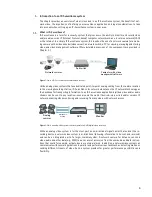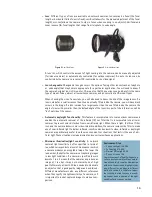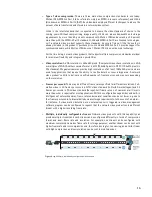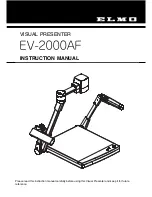
13
b)
Feature considerations
>
Image sensor:
Two types of image sensor technologies are available for use in network cameras:
CCD (charge-coupled device) and CMOS (complementary metal-oxide semiconductor). Each has
its own unique strengths and weaknesses that make them appropriate for different applications.
CCD sensors have been used in cameras for more than 20 years and present many advantageous
qualities such as good light sensitivity, which is important in low-light conditions. However, they
are more expensive and more complex to incorporate into a camera and may consume much more
power than an equivalent CMOS sensor.
Figure 2.1.j.
CCD
Figure 2.1.k.
CMOS
Recent advances in CMOS sensors bring them closer to their CCD counterparts in terms of image
quality. CMOS sensors lower the total cost for cameras since they contain all the logics needed to
build cameras around them. CMOS sensors enable more integration possibilities and more
functions. They make it possible for manufacturers to produce smaller-sized cameras.
The most common image sensor sizes used in network cameras are ¼-inch and 1/3-inch and they
may use progressive scan or interlaced scan technology (see next point below for more on the
technologies). Many megapixel sensors are the same size as sensors used in cameras that deliver
VGA 640x480 resolution. It means that the megapixel sensor has many more pixels but the pixel
sizes are smaller, and therefore, less light sensitive than a non-megapixel sensor.
>
Progressive scan
: This technology involves exposing, capturing and presenting an entire image at
one time—line by line in perfect order, rather than splitting an image into two separate fields and
presenting them at separate times as with analog interlaced scanning technology. Since PC
monitors use progressive scan technology, moving objects in a video will be presented more clearly
on PC screens if the video is captured using progressive scan. If interlaced video is presented on a
PC screen, objects that move between the image capture of two interlaced fields will be blurry. All
of Axis’ current network cameras, with the exception of a couple of PTZ dome cameras, use progres-
sive scan technology.
Progressive scan
An interlaced scan image shown on a progressive PC monitor
Figure 2.1.l.
Freeze frame on moving
dot using progressive scan
Figure 2.1.m.
1st field: Odd lines
2nd field: Even lines
[17/20 ms (NTSC/PAL) later]
Freeze frame on moving
dot using interlaced scan
Summary of Contents for IP-Surveillance system
Page 49: ...49 ...














































